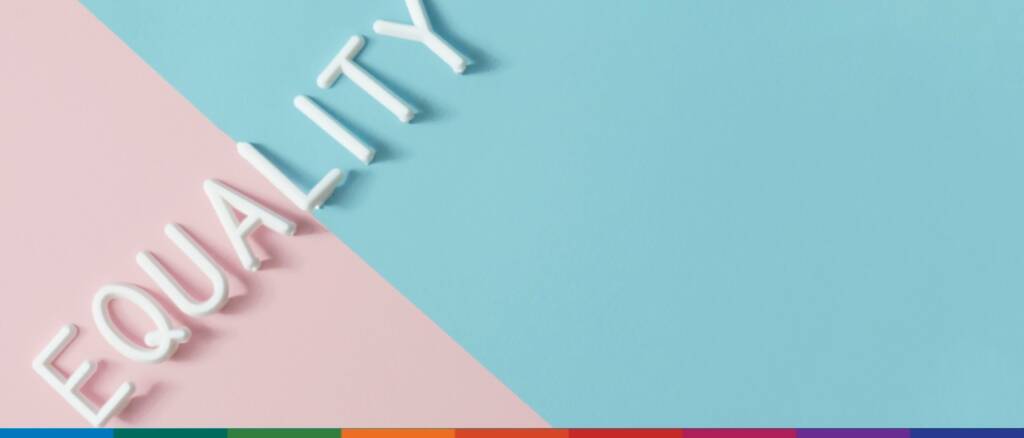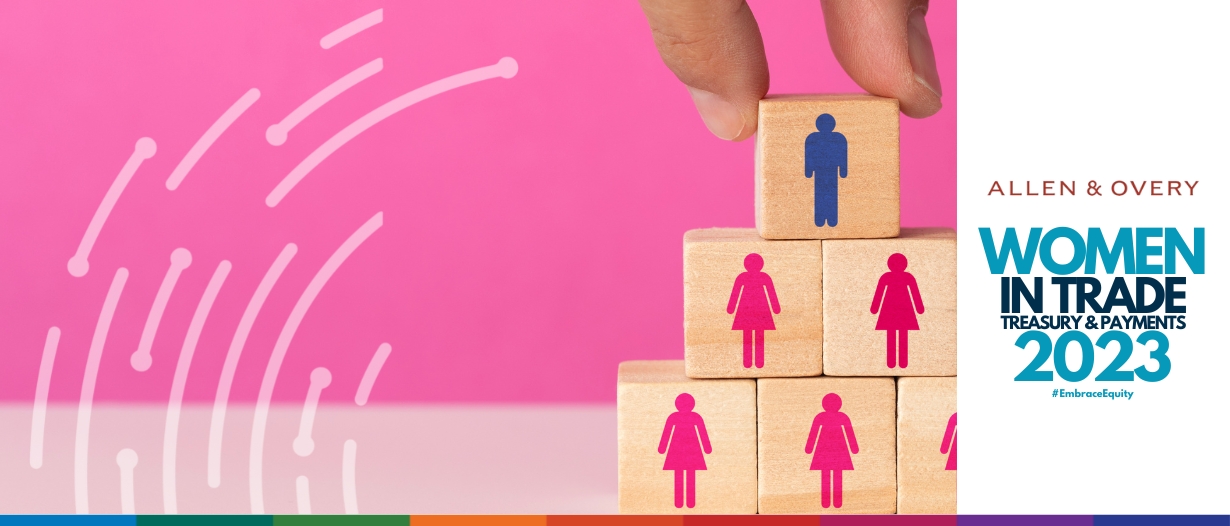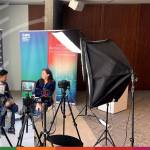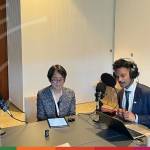Listen to this podcast on Spotify, Apple Podcasts, Podbean, Podtail, ListenNotes, TuneIn
Prejudice, stereotypes and other barriers have prevented women from fully participating and advancing in many industries.
Overcoming these barriers and enhancing women’s social, economic, cultural, and political advancement will require complex and uncomfortable conversations from leaders across these industries.
As part of our Women in Trade Campaign, Trade Finance Global’s Natasha Roston spoke with Catherine Lang-Anderson, partner at Allen & Overy, to hear about her personal experiences and lessons learned as a female leader in the legal industry.

A leaky pipeline
Despite efforts to promote diversity, equity, and inclusion, women still encounter challenges in advancing up the promotion ranks at many firms worldwide.
Women tend to face the “leaky pipeline” phenomenon, where they are well-represented at the entry-level but underrepresented in leadership positions.
This can be due to gender bias, lack of mentorship and sponsorship, family responsibilities, and inflexible work arrangements.
Finding mentors and role models who can guide career aspirations cannot be overstated and is crucial in promoting gender equality at the firm level.
Having female role models within the company or industry can be game-changing for aspiring women who can learn from their experiences and develop strategies for approaching their careers and overcoming barriers.
Lang-Anderson said, “The important thing to remember is you don’t have to find somebody who fits exactly what you want to be in every aspect. You can look to various senior leaders and cherry-pick the aspects of how they approach their career that is aligned to what you want things to look like.”
Male colleagues can also be great role models, allies, and advocates for gender equity in the workplace. Promoting gender equality at the firm level requires concerted efforts from leaders, managers, and employees – male and female alike.
Equality is still a work in progress
Over the past decade, there has been progress towards gender equality in law firms, but there is still work to be done to address the barriers facing women in advancing their careers.
However, on many metrics, patience and intentional monitoring are critical. It takes time to develop lawyers, from graduates to partners and that progress needs to be tracked across the entire pipeline.
Creating a more diverse, inclusive, and supportive workplace culture, providing mentorship and sponsorship opportunities, and flexible work arrangements can help promote gender equality and support women’s career advancement.
Law firms must continue to focus on diversity, equity, and inclusion and not shy away from having conversations about it.
Lang-Anderson said, “We used to talk about just diversity. Then it was diversity and inclusion. Now it’s diversity, equity, and inclusion – which is such an important recognition that levelling the playing field is key. I think the ‘E’ is actually so fundamental to it all. We need to build an equitable platform for diversity and inclusion to flourish.”
However, it is not just gender imbalances that plague many firms today; they need to improve in every aspect, including gender, race and ethnicity, LGBTQ+, disability, and social mobility.
To improve equity, these firms must focus on creating a level playing field, removing barriers, and acknowledging that not everyone comes from the same place. Also, law firms need to focus on the intersectionality of all aspects of diversity and not further divide people into sub-boxes.
One social phenomenon that can help with this is the 30% threshold.

The 30% threshold
The 30% threshold refers to the percentage of representation needed in a group to address the problem of tokenism and bias.
Research has shown that when a particular group is underrepresented, such as women in leadership positions, the presence of only one or two individuals can lead to them being perceived as representatives of the entire group.
This puts a heavy burden on the individuals and can also perpetuate stereotypes and biases.
However, once a group reaches a critical mass of 30%, the problem of tokenism begins to dissipate.
At this threshold, the group becomes more normalised, and individuals are no longer perceived as tokens or representatives of their entire group because there are enough individuals to showcase the diversity and individuality of the members.
Reaching this threshold can also positively impact the group as a whole, as it provides a more supportive environment for all members to thrive and be recognised for their individual contributions.
Lang-Anderson said, “The ultimate goal is still to strive towards full representation and diversity, but once you get to 30%, progress towards achieving that goal of a more inclusive and supportive environment will happen more naturally.”
This progress is also contingent on incumbent senior leaders being comfortable challenging the status quo and continually redrawing their own personal maps of understanding.

Personal maps of understanding
Personal maps of understanding are the mental frameworks that individuals use to make sense of the world around them. These maps are built over time and are shaped by a person’s experiences, beliefs, values, and cultural background.
Like physical maps, personal maps of understanding can only be broadened if regularly updated and expanded. By sharing our stories and experiences with others, we can challenge preconceived notions and biases and help others create a more accurate and nuanced map of the world.
For example, in the context of gender equity in the workplace, personal maps of understanding can play a crucial role in breaking down gender stereotypes and biases. By acknowledging that everyone has a unique perspective and journey, we can begin to recognise and challenge our assumptions about people based on their gender.
Updating and expanding our maps of understanding requires us to be open to learning and willing to embrace discomfort. It involves recognising that what we know about the world may not be complete or accurate, and being ready to challenge our assumptions and beliefs.
Ultimately, by expanding our maps of understanding, we can create a more equitable and inclusive society where everyone’s experiences and perspectives are valued and respected.
Benefits of a new perspective
The value of seeing the world differently is that it allows individuals to challenge their assumptions and biases and to consider alternative perspectives.
This can lead to personal growth and development, as well as positive changes in society.
The overarching zeitgeist surrounding race and gender has evolved and is prompting many firms to take concrete steps towards addressing issues of equity and representation in their industry.
By recognising that there is still work to be done and setting targets for improvement, firms can demonstrate a willingness to listen, learn, and take action.
Ultimately, seeing the world differently can help us build more inclusive and equitable communities where everyone can thrive.
“With that springboard, who knows what kind of change we can achieve next,” Lang-Anderson said.

































